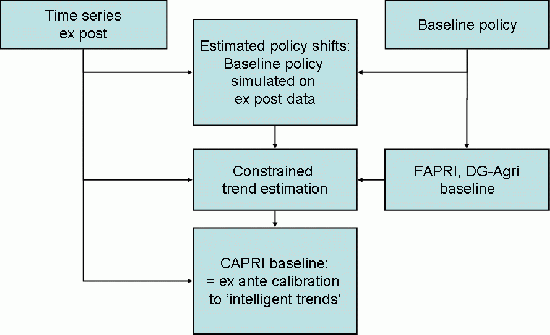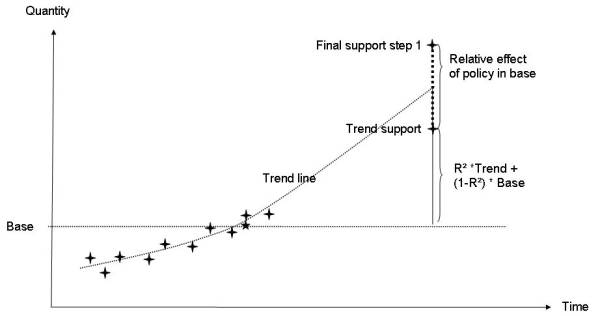Reference run
Overview
 The reference run or baseline serves as a reference point for ex-ante impact analysis with CAPRI. It reflects the most probable development in agricultural markets from global to regional scale for 8-10 year time horizon, at the current legislation. It integrates agricultural market projections from other institutions as OECD, FAPRI, FAO and DG-AGRI. Unique for CAPRI is the regional resolution below the national level for EU27 at the level of NUTS 2 regions and farm types inside NUTS 2 region, and the Bayesian methodology applied. The supply and market module are calibrated to results of the reference run. In opposite to many other reference run approaches, CAPRI employs a Bayesian estimation framework to define a mutually consistent set of projection values for activity levels, yields, production, feed and processing demand, human consumption, trade etc. Basically, all major equations from the supply and market modules are defined as in an optimization framework which maximizes the joint posterior density for given a priori distribution of the different elements. The a priori distribution is wherever possible derived to from exogenous forecasts or expert information. [
The reference run or baseline serves as a reference point for ex-ante impact analysis with CAPRI. It reflects the most probable development in agricultural markets from global to regional scale for 8-10 year time horizon, at the current legislation. It integrates agricultural market projections from other institutions as OECD, FAPRI, FAO and DG-AGRI. Unique for CAPRI is the regional resolution below the national level for EU27 at the level of NUTS 2 regions and farm types inside NUTS 2 region, and the Bayesian methodology applied. The supply and market module are calibrated to results of the reference run. In opposite to many other reference run approaches, CAPRI employs a Bayesian estimation framework to define a mutually consistent set of projection values for activity levels, yields, production, feed and processing demand, human consumption, trade etc. Basically, all major equations from the supply and market modules are defined as in an optimization framework which maximizes the joint posterior density for given a priori distribution of the different elements. The a priori distribution is wherever possible derived to from exogenous forecasts or expert information. [
Methodology
 The a priori distributions are derived from two different sources. For all elements, long term trends are projected. Using “no change” as the zero hypothesis, a weighted average between the base year value and the trend estimate is calculated, using R squared as weight for the trend estimate. The resulting estimates along with the estimation error of the trend deliver a priori distributions for all items in the estimation framework. In a first step, the estimation is solved for these trend support, indepedently for each country. Afterwards, results are aggregated to EU. The projections of other instutions are then added, and replace where available the supports based on trends. If the projections are only reporting values for the EU and not for individual countries, the country results from the first steps are used to distributed the EU estimate. The standard errors for the there projections, especially for those provided by DG-AGRI, is set rather narrow, ensuring that the values are recovered as long as they do not violate the consistency restrictions. The estimation is then repeated in a second step based on the updated supports. The country results are then taken is given, and broken down in a similar framework to NUTS 2 level, and from there to farm type groups.
The a priori distributions are derived from two different sources. For all elements, long term trends are projected. Using “no change” as the zero hypothesis, a weighted average between the base year value and the trend estimate is calculated, using R squared as weight for the trend estimate. The resulting estimates along with the estimation error of the trend deliver a priori distributions for all items in the estimation framework. In a first step, the estimation is solved for these trend support, indepedently for each country. Afterwards, results are aggregated to EU. The projections of other instutions are then added, and replace where available the supports based on trends. If the projections are only reporting values for the EU and not for individual countries, the country results from the first steps are used to distributed the EU estimate. The standard errors for the there projections, especially for those provided by DG-AGRI, is set rather narrow, ensuring that the values are recovered as long as they do not violate the consistency restrictions. The estimation is then repeated in a second step based on the updated supports. The country results are then taken is given, and broken down in a similar framework to NUTS 2 level, and from there to farm type groups.
Quality control (validation)
The reference run can easily comprise several million data points, due to the detailed geographical resolution and to the rich set of agricultural activities and food commodities covered by the CAPRI modelling system. In order to ease the validation, results of the reference run are accessible via the Graphical User Interface, where several reporting tables aggregate over activities, commodities and countries. With the help of the GUI, analysts can compare systematically the subsequent steps of the baseline procedure.
Nevertheless, checking results for plausibility remains a challenge. An interesting comparison of the methdology between the reference run exercise for the OECD/FAO AGLINK-COSIMO model with an estimated input of 20 person months and the CAPRI reference run with an estimated inputs of about 2 person months is reported by Adenauer 2008.
Calibration to the EC mid-term market outlook
The CAPRI baseline is regularly calibrated to the mid-term commodity outlook of the European Commission. More on the technical and institutional aspects can be found in the following JRC reports:
Calibrating CAPRI to the mid-term commodity outlook of the EC
Background information on the baseline construction process
More information
Witzke H.P. and Adenaeuer M.:
Capri Baseline (pdf, 13 slides)
Last Updated:Tuesday, October 28, 2008



